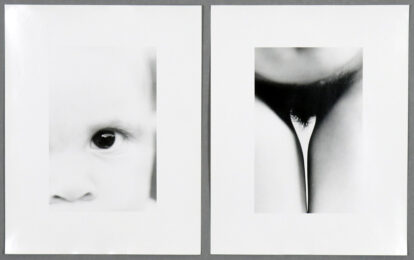

Ralph Gibson’ delicately stunning photographs have a dreamlike quality. Speaking of his work, he once said “The alchemy of photography lies in taking unimportant objects or events and surpassing their appearance.” Often working in sequences and playing with surrealism, during the years 1971 to 1998, Gibson worked on a long series of photographs called Infanta, which came about from Gibson’s fascination with feminine beauty, of which the “Child and Woman” diptych is part of. In this pair of silver prints, Gibson juxtaposes two eidetic images, one of a woman’s thighs and the other of a child’s face peering intently into the camera’s lens. Here Gibson illustrates his theory that when two images are placed side by side, they “coalesce” on the viewer’s retina to produce a third image that appears between the two original images. In this work, this surrealist tactic forms a powerful motif that captures the cycle of life from conception to birth, from the origin to the originated, from woman to child. The effect is at once both organic abstracted, powerfully emotive yet captured with the photographer’s cool eye for detail and design, highly personal yet universal in its relevance to us all.
Also from the Infanta series, Striped Nude was originally shot in 1981. While working on this series, Gibson came to see light as intricately linked to the image of feminine elegance: “Beauty in women inhabits a force field charged with particles of light,” he said. “It is almost as if the light is the subject, and the woman the source of the light.” The original photograph of Leda was shot in 1974. Leda refers to the Greek myth of Leda and the Swan, in which the god Zeus, in the form of a swan, consorted with a mortal woman, named Leda. Leda would later lay an egg from which Helen of Troy, daughter of Zeus, would hatch. Gibson’s stylized interpretation of this story – a tale that inspired some of the classic paintings of the Renaissance – has proved to be one of his most popular images.